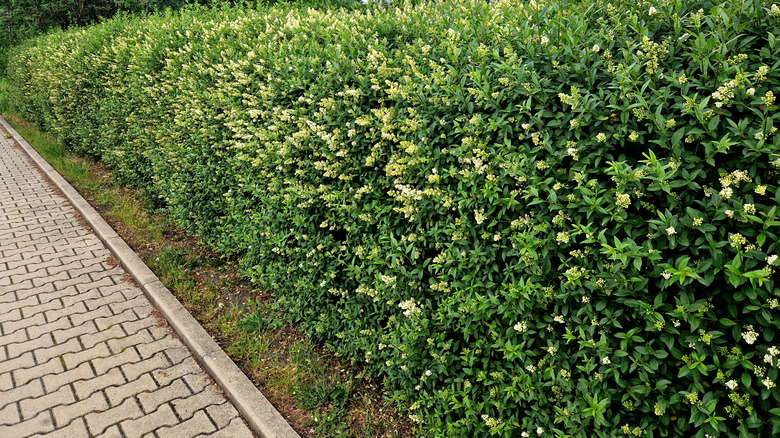The Popular Landscaping Hedge You Don't Want Growing Next To Your Home
A thick hedge enhances aesthetics, privacy, and security. Hedges create a visual barrier that defines property lines, provides noise and wind reduction benefits, and is less expensive and more sustainable than a fence. The popular landscape hedge that you need to be careful about near your home is privet (Ligustrum spp.). Privet is one of the plants you shouldn't grow right next to your house for several reasons.
Privet arrived in the United States from Asia in the mid-19th century and gained popularity for landscaping, including hedges. There are four different species, although differentiating them can be challenging. They have similar impacts on the ecosystem and their classification as a noxious weed or invasive species means it is illegal to intentionally plant them in certain states.
The thickness and height of privet make it popular for a hedgerow. Privet can reach heights of up to 15 feet. The leaves have an oppositional arrangement with gray stems. Flowers bloom in May and June, followed by green fruit growing in the summer. The berries eventually turn bluish-black and remain on the stems into the winter.
Reasons to avoid privet near the house
Privet is one of the fast-spreading invasive privacy plants to avoid due to its rapid growth rate and listing as an invasive species in several states. Privet hedges that are planted too close to the house can grow until they cover the walls, block out windows, and creep into tiny crevices and small cracks. This can result in damage to foundations of homes, concrete driveways, walkways, patios, and underground water pipes.
The berries on this shrub attract wildlife, especially birds, which can present a few problems. The birds can create a mess, and they can disperse privet seeds, which allow the shrub to become established in forested areas. Once there, it outcompetes with and displaces natural vegetation. This can change the balance of the local ecosystem and has a detrimental impact on pollinators.
In addition to causing potential property damage and disrupting the environment, privet is not great for your health. Privet leaves and berries are mildly toxic and can cause irritation to the mouth, skin reactions, and gastrointestinal distress, so it may not be safe around children and pets. The pollen can trigger respiratory allergies and asthma attacks.
Better options for planting hedges
Due to concerns about the balance of the local ecosystem, potential property damage, and the safety of pets or children, you may want to skip privet and plant something less troublesome. There are many factors to consider when selecting the ideal plants for a hedge, including how much sun and shade they can tolerate and the amount of water required for them to grow healthy.
Some plants to consider include Japanese camellias (Camellia japonica), wax myrtle (Myrica cerifera), Lily-of-the-Valley (Pieris ryukyuensis), evergreen hollies (Ilex spp.), and anise shrubs (Illicium ssp.). You may want to consider Martha Stewart's plant recommendation for a lush privacy hedge: 'Green Mountain' boxwoods (Buxus 'Green Mountain'). This is a full, evergreen shrub that is deer resistant and ideal for privacy without becoming invasive or overly aggressive.
If you are replacing privet with a new shrub for your hedges, you will need patience to completely eradicate it from your property. The privet shrubs will need to be uprooted when possible or cut down and treated with an herbicide to kill the roots. If you don't want to use an herbicide, the plants will regrow and need to be cut again until the roots eventually starve.


